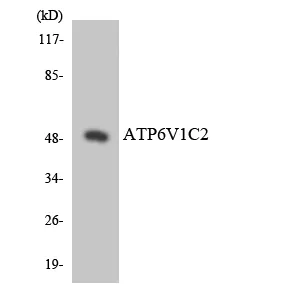

Size:50μL Price:$118
Size:100μL Price:$220
Size:200μL Price:$380
Application:WB,ELISA
Reactivity:Human,Rat,Mouse
Conjugate:Unconjugated
Optional conjugates: Biotin, FITC (free of charge). See other 26 conjugates.
Gene Name:ATP6V1C2
Summary
| Production Name | V-ATPase C2 Rabbit Polyclonal Antibody |
| Description | Rabbit polyclonal Antibody |
| Host | Rabbit |
| Application | WB,ELISA |
| Reactivity | Human,Rat,Mouse |
Performance
| Conjugation | Unconjugated |
| Modification | Unmodified |
| Isotype | IgG |
| Clonality | Polyclonal |
| Form | Liquid |
| Storage | Store at 4°C short term. Aliquot and store at -20°C long term. Avoid freeze/thaw cycles. |
| Buffer | Liquid in PBS containing 50% glycerol, 0.5% protective protein and 0.02% New type preservative N. |
| Purification | Affinity purification |
Immunogen
| Gene Name | ATP6V1C2 |
| Alternative Names | ATP6V1C2; V-type proton ATPase subunit C 2; V-ATPase subunit C 2; Vacuolar proton pump subunit C 2 |
| Gene ID | 245973 |
| SwissProt ID | Q8NEY4 |
Application
| Dilution Ratio | WB 1:500-1:2000,ELISA 1:10000-1:20000 |
| Molecular Weight | 48kDa |
Background
This gene encodes a component of vacuolar ATPase (V-ATPase), a multisubunit enzyme that mediates acidification of eukaryotic intracellular organelles. V-ATPase dependent organelle acidification is necessary for such intracellular processes as protein sorting, zymogen activation, receptor-mediated endocytosis, and synaptic vesicle proton gradient generation. V-ATPase is composed of a cytosolic V1 domain and a transmembrane V0 domain. The V1 domain consists of three A,three B, and two G subunits, as well as a C, D, E, F, and H subunit. The V1 domain contains the ATP catalytic site. This gene encodes alternate transcriptional splice variants, encoding different V1 domain C subunit isoforms. [provided by RefSeq, Jul 2008],function:Subunit of the peripheral V1 complex of vacuolar ATPase. Subunit C is necessary for the assembly of the catalytic sector of the enzyme and is likely to have a specific function in its catalytic activity. V-ATPase is responsible for acidifying a variety of intracellular compartments in eukaryotic cells.,similarity:Belongs to the V-ATPase C subunit family.,subunit:V-ATPase is an heteromultimeric enzyme composed of a peripheral catalytic V1 complex (components A to H) attached to an integral membrane V0 proton pore complex (components: a, c, c', c'' and d).,tissue specificity:Kidney and placenta.,
Research Area
Oxidative phosphorylation;Vibrio cholerae infection;Epithelial cell signaling in Helicobacter pylori infection;
